Evaluation of the Snow Albedo Retrieved from the Snow Kernel Improved the Ross-Roujean BRDF Model
Abstract
1. Introduction
2. Materials
2.1. Simulated Data of the bic-PT Model
2.2. Field-Measured Data
2.3. POLDER BRDF Database
3. Models and Methods
3.1. Kernel-Driven Model
3.1.1. RTR Model
3.1.2. RTS Model
3.2. Evaluation Method for the Kernel-Driven Models.
4. Results and Analysis
4.1. Results Using the bic-PT Model
4.1.1. Evaluating the Models in Fitting the Snow Simulation BRDFs
4.1.2. Evaluating the Models in Estimating Snow Albedo
4.1.3. Investigating the Angular Sampling Influence on Snow Albedo Retrieval
4.2. Results with Field-Measured Data
4.3. Results of Retrieved Albedo Using POLDER Data
5. Discussion
6. Conclusions
Author Contributions
Acknowledgments
Conflicts of Interest
References
- Qu, Y.; Liang, S.; Liu, Q.; Li, X.; Feng, Y.; Liu, S. Estimating Arctic Sea-Ice Shortwave Albedo from MODIS Data. Remote Sens. Environ. 2016, 186, 32–46. [Google Scholar] [CrossRef]
- Wang, Z.; Schaaf, C.B.; Strahler, A.H.; Chopping, M.J.; Román, M.O.; Shuai, Y.; Woodcock, C.E.; Hollinger, D.Y.; Fitzjarrald, D.R. Evaluation of MODIS Albedo Product (MCD43A) Over Grassland, Agriculture and Forest Surface Types During Dormant and Snow-Covered Periods. Remote Sens. Environ. 2014, 140, 60–77. [Google Scholar] [CrossRef]
- Stroeve, J.; Box, J.E.; Wang, Z.; Schaaf, C.; Barrett, A. Re-Evaluation of MODIS MCD43 Greenland Albedo Accuracy and Trends. Remote Sens. Environ. 2013, 138, 199–214. [Google Scholar] [CrossRef]
- Wang, Z.; Schaaf, C.B.; Chopping, M.J.; Strahler, A.H.; Wang, J.; Román, M.O.; Rocha, A.V.; Woodcock, C.E.; Shuai, Y. Evaluation of Moderate-Resolution Imaging Spectroradiometer (MODIS) Snow Albedo Product (MCD43A) Over Tundra. Remote Sens. Environ. 2012, 117, 264–280. [Google Scholar] [CrossRef]
- Stroeve, J.C.; Box, J.E.; Haran, T. Evaluation of the MODIS (MOD10A1) Daily Snow Albedo Product Over the Greenland Ice Sheet. Remote Sens. Environ. 2006, 105, 155–171. [Google Scholar] [CrossRef]
- Stroeve, J.; Box, J.E.; Gao, F.; Liang, S.; Nolin, A.; Schaaf, C. Accuracy Assessment of the MODIS 16-Day Albedo Product for Snow: Comparisons with Greenland in Situ Measurements. Remote Sens. Environ. 2005, 94, 46–60. [Google Scholar] [CrossRef]
- Liang, S.; Stroeve, J.C.; Box, J.E. Mapping Daily Snow/Ice Shortwave Broadband Albedo from Moderate Resolution Imaging Spectroradiometer (MODIS): The Improved Direct Retrieval Algorithm and Validation with Greenland in Situ Measurement. J. Geophys. Res. 2005, 110, 1–10. [Google Scholar] [CrossRef]
- Robinson, D.A.; Dewey, K.F.; Heim, R.R. Global Snow Cover Monitoring—An Update. Bull. Am. Meteorol. Soc. 1993, 74, 1689–1696. [Google Scholar] [CrossRef]
- Henderson-Sellers, A.; Wilson, M.F. Surface Albedo Data for Climatic Modeling. Rev. Geophys. 1983, 21, 1743–1778. [Google Scholar] [CrossRef]
- Jacob, F.; Olioso, A. Derivation of Diurnal Courses of Albedo and Reflected Solar Irradiance from Airborne POLDER Data Acquired Near Solar Noon. J. Geophys. Res. Atmos. 2005, 110, 1–18. [Google Scholar] [CrossRef]
- Barry, R.G. Detecting the Climate Effects of Increasing CO2; Technical Report No DOE/ER-0235; Department of Energy: Washington, DC, USA, 1985; pp. 109–141.
- Sellers, P.J.; Meeson, B.W.; Hall, F.G.; Asrar, G.; Murphy, R.E.; Schiffer, R.A.; Bretherton, F.P.; Dickinson, R.E.; Ellingson, R.G.; Field, C.B. Remote Sensing of the Land Surface for Studies of Global Change: Models—Algorithms—Experiments. Remote Sens. Environ. 1995, 39, 3–26. [Google Scholar] [CrossRef]
- Liu, Y.; Wang, Z.; Sun, Q.; Erb, A.M.; Li, Z.; Schaaf, C.B.; Zhang, X.; Román, M.O.; Scott, R.L.; Zhang, Q.; et al. Evaluation of the VIIRS BRDF, Albedo and Nbar Products Suite and an Assessment of Continuity with the Long Term MODIS Record. Remote Sens. Environ. 2017, 201, 256–274. [Google Scholar] [CrossRef]
- Schaepman-Strub, G.; Schaepman, M.E.; Painter, T.H.; Dangel, S.; Martonchik, J.V. Reflectance Quantities in Optical Remote Sensing—Definitions and Case Studies. Remote Sens. Environ. 2006, 103, 27–42. [Google Scholar] [CrossRef]
- Bréon, F.; Maignan, F. A BRDF–BPDF Database for the Analysis of Earth Target Reflectances. Earth Syst. Sci. Data 2017, 9, 31–45. [Google Scholar] [CrossRef]
- Gatebe, C.K.; King, M.D. Airborne Spectral BRDF of Various Surface Types (Ocean, Vegetation, Snow, Desert, Wetlands, Cloud Decks, Smoke Layers) for Remote Sensing Applications. Remote Sens. Environ. 2016, 179, 131–148. [Google Scholar] [CrossRef]
- Peltoniemi, J.I.; Kaasalainen, S.; Naranen, J.; Matikainen, L.; Piironen, J. Measurement of Directional and Spectral Signatures of Light Reflectance by Snow. IEEE Trans. Geosci. Remote Sens. 2005, 43, 2294–2304. [Google Scholar] [CrossRef]
- Wiscombe, W.J.; Warren, S.G. A Model for the Spectral Albedo of Snow. 1: Pure Snow. J. Atmos. Sci. 1980, 37, 2712–2733. [Google Scholar] [CrossRef]
- Stamnes, K.; Tsay, S.C.; Wiscombe, W.; Jayaweera, K. Numerically Stable Algorithm for Discrete-Ordinate-Method Radiative Transfer in Multiple Scattering and Emitting Layered Media. Appl. Opt. 1988, 27, 2502–2509. [Google Scholar] [CrossRef]
- Kokhanovsky, A.A.; Breon, F.M. Validation of an Analytical Snow BRDF Model Using Parasol Multi-Angular and Multispectral Observations. IEEE Trans. Geosci. Remote Sens. 2012, 9, 928–932. [Google Scholar] [CrossRef]
- Kokhanovsky, A.A.; Zege, E.P. Scattering Optics of Snow. Appl. Opt. 2004, 43, 1589. [Google Scholar] [CrossRef]
- Xiong, C.; Shi, J. Simulating Polarized Light Scattering in Terrestrial Snow Based on Bicontinuous Random Medium and Monte Carlo Ray Tracing. J. Quant. Spectrosc. Radiat. Transf. 2014, 133, 177–189. [Google Scholar] [CrossRef]
- Mishchenko, M.I.; Dlugach, J.M.; Yanovitskij, E.G.; Zakharova, N.T. Bidirectional Reflectance of Flat, Optically Thick Particulate Layers: An Efficient Radiative Transfer Solution and Applications to Snow and Soil Surfaces. J. Quant. Spectrosc. Radiat. Transf. 1999, 63, 409–432. [Google Scholar] [CrossRef]
- Walthall, C.L.; Norman, J.M.; Welles, J.M.; Campbell, G.; Blad, B.L. Simple Equation to Approximate the Bidirectional Reflectance from Vegetative Canopies and Bare Soil Surfaces. Appl. Opt. 1985, 24, 383. [Google Scholar] [CrossRef] [PubMed]
- Shibayama, M. View Azimuth and Zenith, and Solar Angle Effects on Wheat Canopy Reflectance. Remote Sens. Environ. 1985, 18, 91–103. [Google Scholar] [CrossRef]
- Bacour, C.; Bréon, F.M. Variability of Biome Reflectance Directional Signatures as Seen by POLDER. Remote Sens. Environ. 2005, 98, 80–95. [Google Scholar] [CrossRef]
- Lucht, W.; Schaaf, C.B.; Strahler, A.H. An Algorithm for the Retrieval of Albedo from Space Using Semiempirical BRDF Models. IEEE Trans. Geosci. Remote Sens. 2002, 38, 977–998. [Google Scholar] [CrossRef]
- Schaaf, C.B.; Gao, F.; Strahler, A.H.; Lucht, W.; Li, X.; Tsang, T.; Strugnell, N.C.; Zhang, X.; Jin, Y.; Muller, J.P. First Operational BRDF, Albedo Nadir Reflectance Products from MODIS. Remote Sens. Environ. 2002, 83, 135–148. [Google Scholar] [CrossRef]
- Lucht, W.; Roujean, J.L. Considerations in the Parametric Modeling of BRDF and Albedo from Multiangular Satellite Sensor Observations. Remote Sens. Rev. 2000, 18, 343–379. [Google Scholar] [CrossRef]
- Rahman, H.; Pinty, B.; Verstraete, M.M. Coupled Surface-Atmosphere Reflectance (CSAR) Model 2. Semiempirical Surface Model Usable with NOAA Advanced Very High Resolution Radiometer Data. J. Geophys. Res. Atmos. 1993, 98, 20791–20801. [Google Scholar] [CrossRef]
- Roujean, J.L.; Leroy, M.; Deschamps, P.Y. A Bidirectional Reflectance Model of the Earths Surface for the Correction of Remote-Sensing Data. J. Geophys. Res. Atmos. 1992, 97, 20455–20468. [Google Scholar] [CrossRef]
- Jiao, Z.; Ding, A.; Kokhanovsky, A.; Schaaf, C.; Bréon, F.; Dong, Y.; Wang, Z.; Liu, Y.; Zhang, X.; Yin, S.; et al. Development of a Snow Kernel to Better Model the Anisotropic Reflectance of Pure Snow in a Kernel-Driven BRDF Model Framework. Remote Sens. Environ. 2019, 221, 198–209. [Google Scholar] [CrossRef]
- Dong, Y.; Jiao, Z.; Ding, A.; Zhang, H.; Zhang, X.; Li, Y.; He, D.; Yin, S.; Cui, L. A Modified Version of the Kernel-Driven Model for Correcting the Diffuse Light of Ground Multi-Angular Measurements. Remote Sens. Environ. 2018, 210, 325–344. [Google Scholar] [CrossRef]
- Jiao, Z.; Dong, Y.; Schaaf, C.B.; Chen, J.M.; Román, M.; Wang, Z.; Zhang, H.; Ding, A.; Erb, A.; Hill, M.J.; et al. An Algorithm for the Retrieval of the Clumping Index (CI) from the MODIS BRDF Product Using an Adjusted Version of the Kernel-Driven BRDF Model. Remote Sens. Environ. 2018, 209, 594–611. [Google Scholar] [CrossRef]
- Jiao, Z.; Zhang, X.; Bréon, F.; Dong, Y.; Schaaf, C.B.; Román, M.; Wang, Z.; Cui, L.; Yin, S.; Ding, A.; et al. The Influence of Spatial Resolution on the Angular Variation Patterns of Optical Reflectance as Retrieved from MODIS and POLDER Measurements. Remote Sens. Environ. 2018, 215, 371–385. [Google Scholar] [CrossRef]
- Zhang, X.; Jiao, Z.; Dong, Y.; Zhang, H.; Li, Y.; He, D.; Ding, A.; Yin, S.; Cui, L.; Chang, Y. Potential Investigation of Linking PROSAIL with the Ross-Li BRDF Model for Vegetation Characterization. Remote Sens. Basel 2018, 10, 437. [Google Scholar] [CrossRef]
- He, T.; Liang, S.; Wang, D.; Cao, Y.; Gao, F.; Yu, Y.; Feng, M. Evaluating Land Surface Albedo Estimation from Landsat MSS, TM, ETM +, and OLI Data Based on the Unified Direct Estimation Approach. Remote Sens. Environ. 2018, 204, 181–196. [Google Scholar] [CrossRef]
- Qu, Y.; Liu, Q.; Liang, S.; Wang, L.; Liu, N.; Liu, S. Direct-Estimation Algorithm for Mapping Daily Land-Surface Broadband Albedo from MODIS Data. IEEE Trans. Geosci. Remote Sens. 2014, 52, 907–919. [Google Scholar] [CrossRef]
- Ding, A.; Jiao, Z.; Dong, Y.; Qu, Y.; Zhang, X.; Xiong, C.; He, D.; Yin, S.; Cui, L.; Chang, Y. An Assessment of the Performance of Two Snow Kernels in Characterizing Snow Scattering Properties. Int. J. Remote Sens. 2019, 40, 6315–6335. [Google Scholar] [CrossRef]
- Mei, L.L.; Rozanov, V.; Christoph, R.; Bernd, H.; Jiao, Z.T.; Vountas, M.; Burrows, J.P. Retrieval of Aerosol Optical Thickness in the Arctic Snow-Covered Regions Using Passive Remote Sensing: Impact of Aerosol Typing and Surface Reflection Model. IEEE Trans. Geosci. Remote Sens. 2019. (under review). [Google Scholar]
- Widlowski, J.L.; Pinty, B.; Clerici, M.; Dai, Y.; De Kauwe, M.; De Ridder, K.; Kallel, A.; Kobayashi, H.; Lavergne, T.; Ni Meister, W. Rami4Pilps: An Intercomparison of Formulations for the Partitioning of Solar Radiation in Land Surface Models. J. Geophys. Res. Biogeosci. 2015, 116, 264–265. [Google Scholar] [CrossRef]
- Pinty, B.; Widlowski, J.L.; Taberner, M.; Gobron, N.; Verstraete, M.M.; Disney, M.; Gascon, F.; Gastellu, J.P.; Jiang, L.; Kuusk, A. Radiation Transfer Model Intercomparison (Rami) Exercise: Results from the Second Phase. J. Geophys. Res. Atmos. 2004, 109, 523–538. [Google Scholar] [CrossRef]
- Pinty, B.; Gobron, N.; Widlowski, J.L.; Gerstl, S.A.W.; Verstraete, M.M.; Antunes, M.; Bacour, C.; Gascon, F.; Gastellu, J.P.; Goel, N. Radiation Transfer Model Intercomparison (RAMI) Exercise. J. Geophys. Res. Atmos. 2001, 106, 523–538. [Google Scholar] [CrossRef]
- Xiong, C.; Shi, J. Snow Specific Surface Area Remote Sensing Retrieval Using a Microstructure Based Reflectance Model. Remote Sens. Environ. 2018, 204, 838–849. [Google Scholar] [CrossRef]
- Peltoniemi, J.I.; Gritsevich, M.; Hakala, T.; Dagsson-Waldhauserová, P.; Arnalds, Ó.; Anttila, K.; Hannula, H.R.; Kivekäs, N.; Lihavainen, H.; Meinander, O.; et al. Soot on Snow Experiment: Bidirectional Reflectance Factor Measurements of Contaminated Snow. Cryosphere 2015, 9, 2323–2337. [Google Scholar] [CrossRef]
- Hakala, T.; Riihelä, A.; Lahtinen, P.; Peltoniemi, J.I. Hemispherical-Directional Reflectance Factor Measurements of Snow on the Greenland Ice Sheet During the Radiation, Snow Characteristics and Albedo at Summit (Rascals) Campaign. J. Quant. Spectrosc. Radiat. Transf. 2014, 146, 280–289. [Google Scholar] [CrossRef]
- Suomalainen, J.; Hakala, T.; Peltoniemi, J.; Puttonen, E. Polarised Multiangular Reflectance Measurements Using the Finnish Geodetic Institute Field Goniospectrometer. Sens. Basel 2009, 9, 3891–3907. [Google Scholar] [CrossRef] [PubMed]
- Peltoniemi, J.; Hakala, T.; Suomalainen, J.; Puttonen, E. Polarised Bidirectional Reflectance Factor Measurements from Soil, Stones, and Snow. J. Quant. Spectrosc. Radiat. Transf. 2009, 110, 1940–1953. [Google Scholar] [CrossRef]
- Kaasalainen, S.; Kaasalainen, M.; Mielonen, T.; Suomalainen, J.; Peltoniemi, J.I.; Naranen, J. Optical Properties of Snow in Backscatter. J. Glaciol. 2006, 52, 574–584. [Google Scholar] [CrossRef]
- Jiao, Z.; Schaaf, C.B.; Dong, Y.; Román, M.; Hill, M.J.; Chen, J.M.; Wang, Z.; Zhang, H.; Saenz, E.; Poudyal, R.; et al. A Method for Improving Hotspot Directional Signatures in BRDF Models Used for MODIS. Remote Sens. Environ. 2016, 186, 135–151. [Google Scholar] [CrossRef]
- Liang, S.; Shuey, C.J.; Russ, A.L.; Fang, H.; Chen, M.; Walthall, C.L.; Daughtry, C.S.T.; Hunt, R. Narrowband to Broadband Conversions of Land Surface Albedo: II. Validation. Remote Sens. Environ. 2003, 84, 25–41. [Google Scholar] [CrossRef]
- Liang, S. Narrowband to Broadband Conversions of Land Surface Albedo I: Algorithms. Remote Sens. Environ. 2001, 76, 213–238. [Google Scholar] [CrossRef]
- Dong, Y.; Jiao, Z.; Zhang, H.; Bai, D.; Zhang, X.; Li, Y.; He, D. A Visualization Tool for the Kernel-Driven Model with Improved Ability in Data Analysis and Kernel Assessment. Comput. Geosci. 2016, 95, 1–10. [Google Scholar] [CrossRef]
- Maignan, F.; Bréon, F.M.; Lacaze, R. Bidirectional Reflectance of Earth Targets: Evaluation of Analytical Models Using a Large Set of Spaceborne Measurements with Emphasis on the Hot Spot. Remote Sens. Environ. 2004, 90, 210–220. [Google Scholar] [CrossRef]
- Pokrovsky, O.; Roujean, J.-L. Land Surface Albedo Retrieval Via Kernel-Based BRDF Modeling: I. Statistical Inversion Method and Model Comparison. Remote Sens. Environ. 2003, 84, 100–119. [Google Scholar] [CrossRef]
- Pokrovsky, O.; Roujean, J.-L. Land Surface Albedo Retrieval Via Kernel-Based BRDF Modeling: Ii. An Optimal Design Scheme for the Angular Sampling. Remote Sens. Environ. 2003, 84, 120–142. [Google Scholar] [CrossRef]
- Su, W.; Liang, L.; Doelling, D.R.; Minnis, P.; Duda, D.P.; Khlopenkov, K.; Thieman, M.M.; Loeb, N.G.; Kato, S.; Valero, F.P.J.; et al. Determining the Shortwave Radiative Flux from Earth Polychromatic Imaging Camera. J. Geophys. Res. Atmos. 2018, 123, 11479–11491. [Google Scholar] [CrossRef]
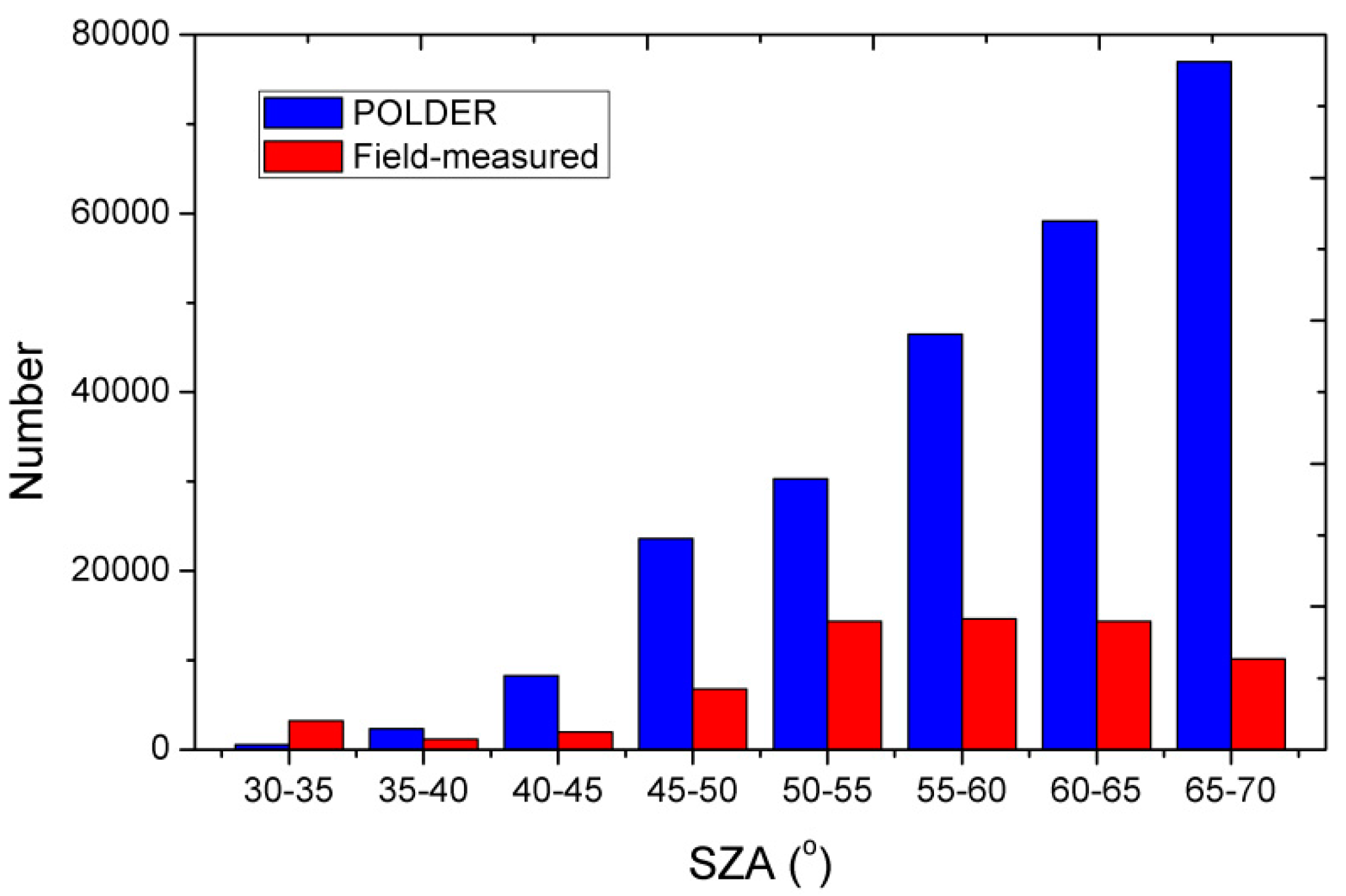
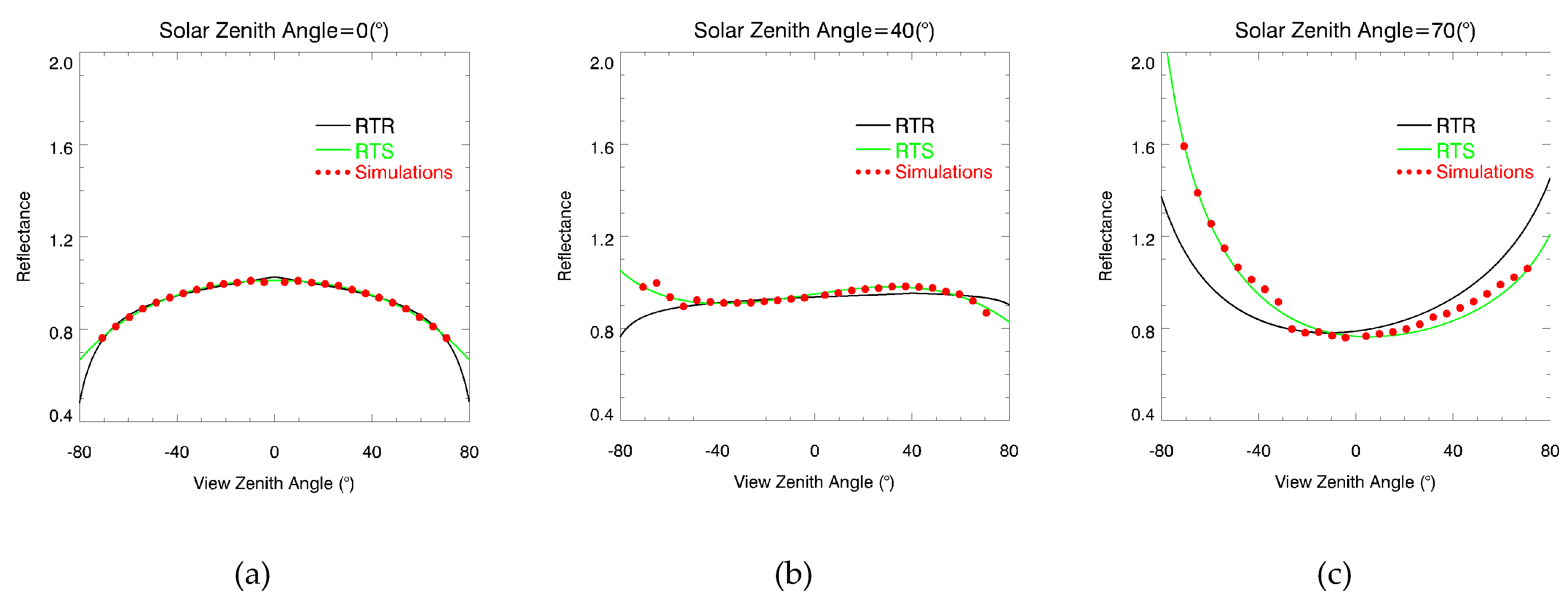
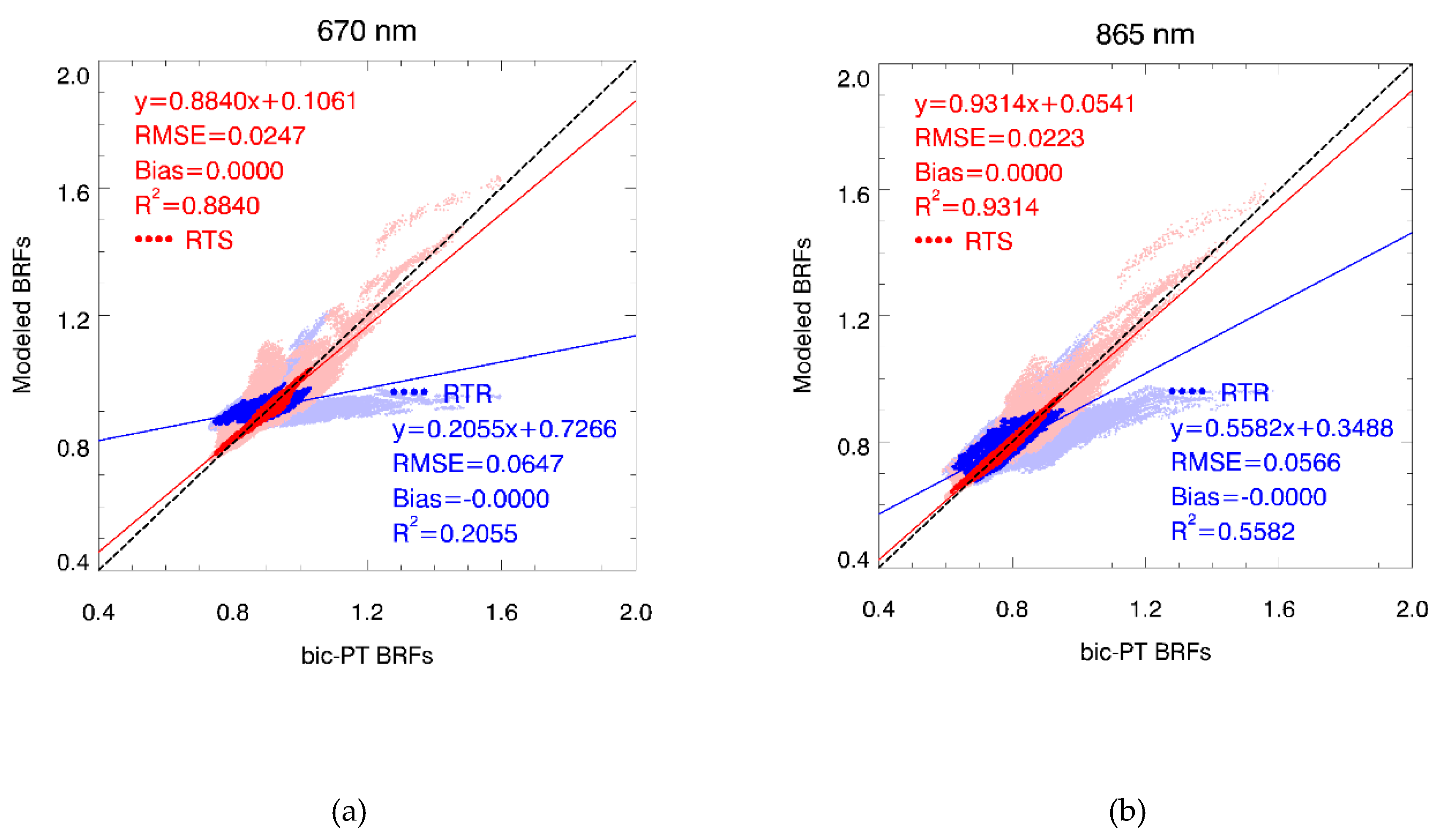
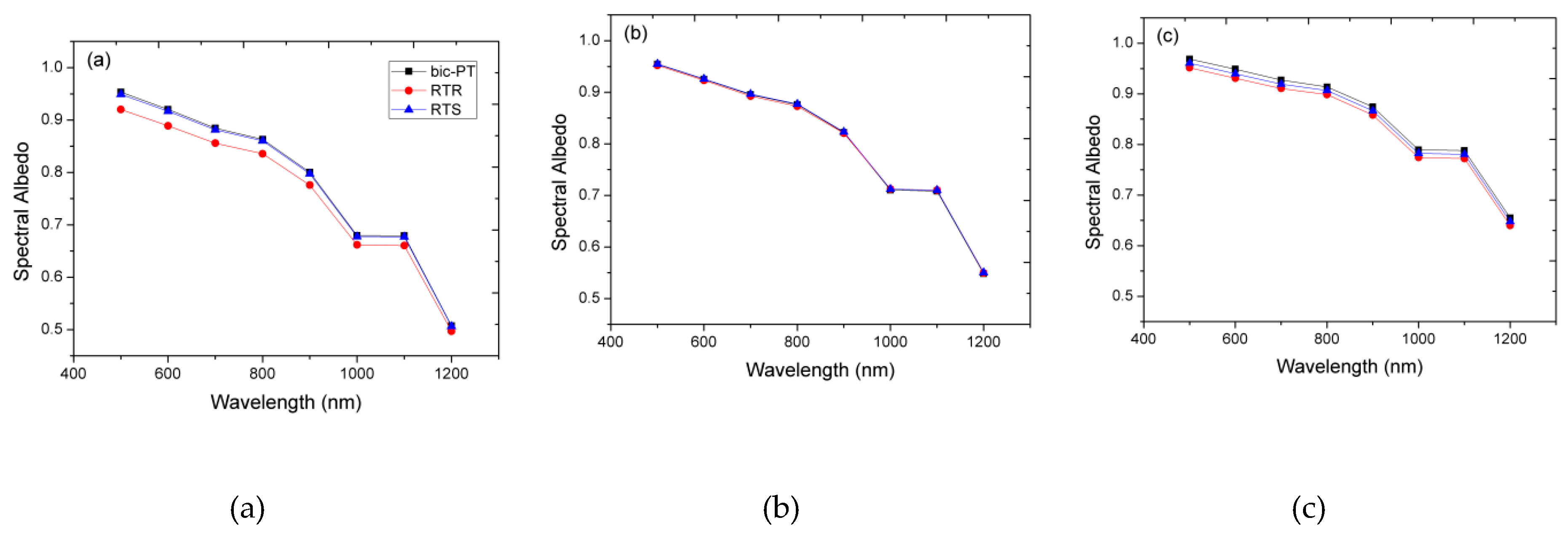
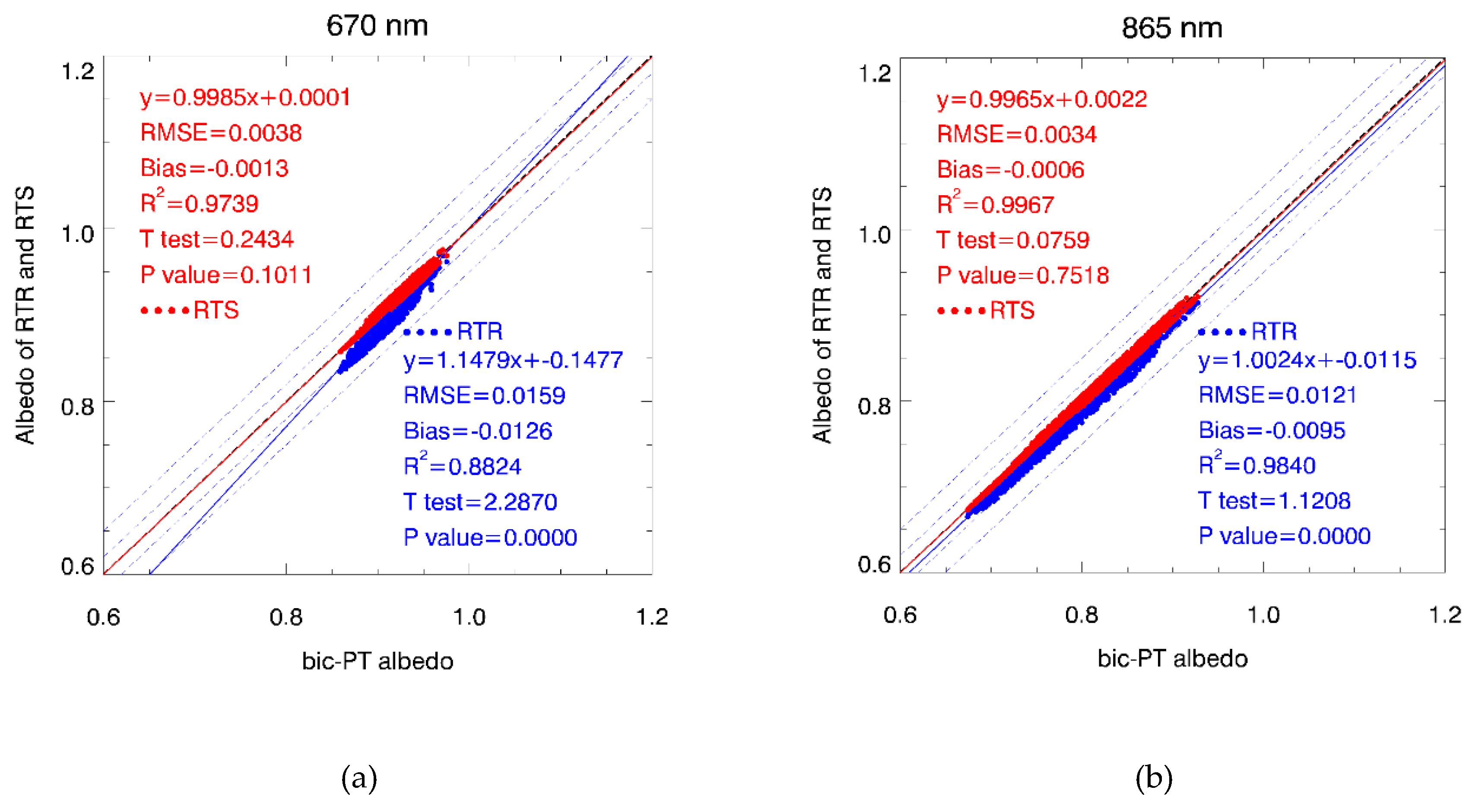
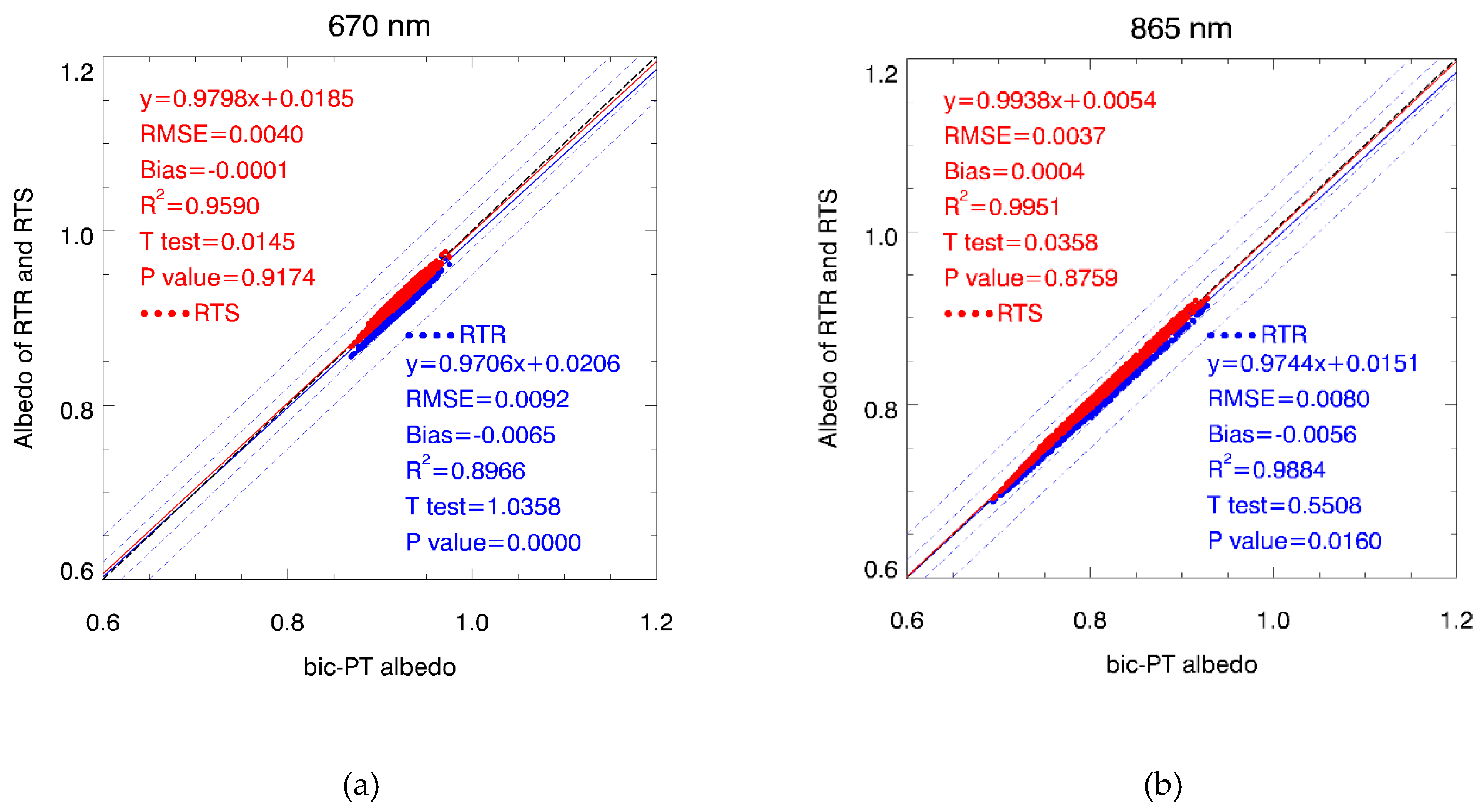

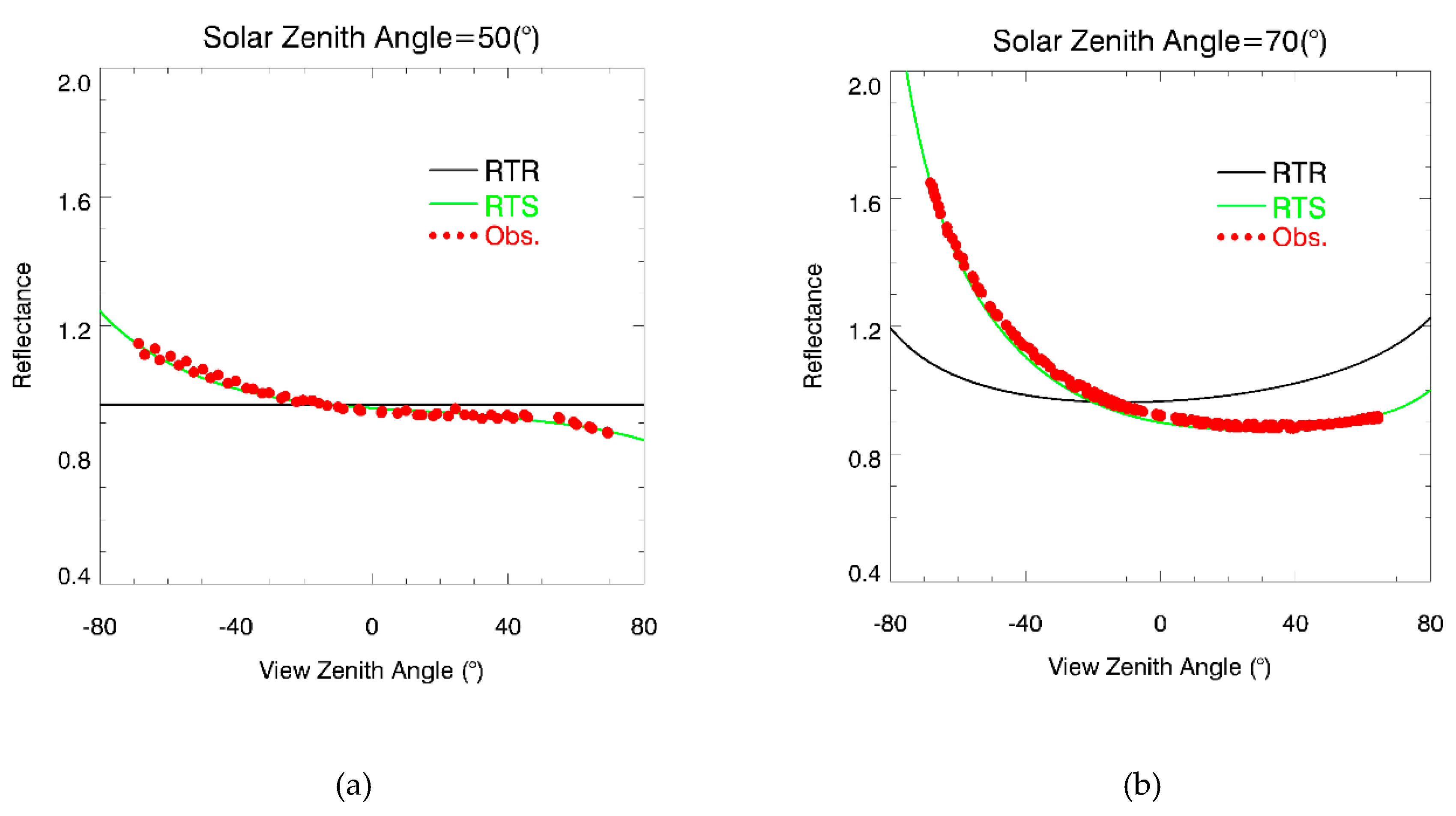
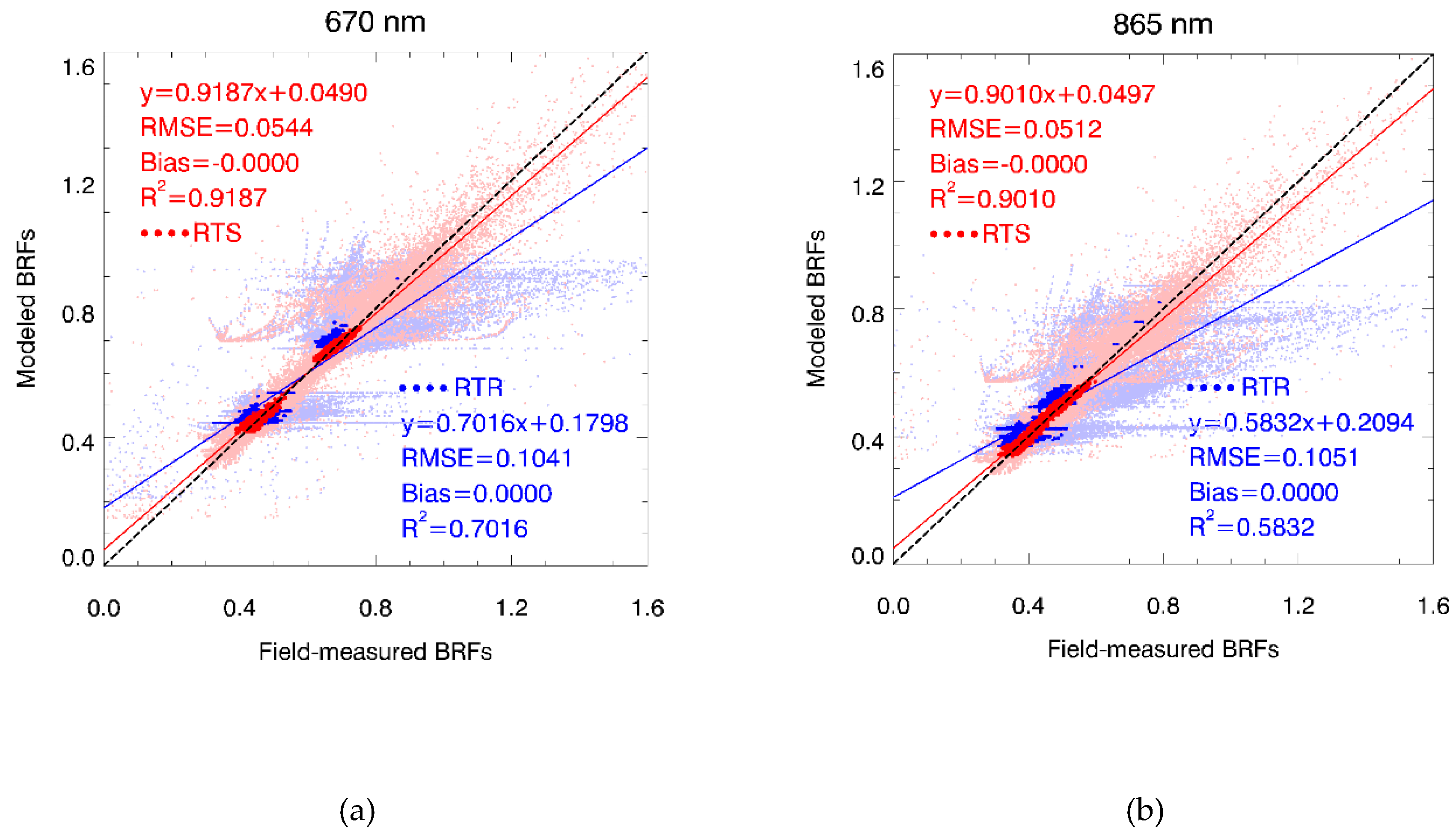
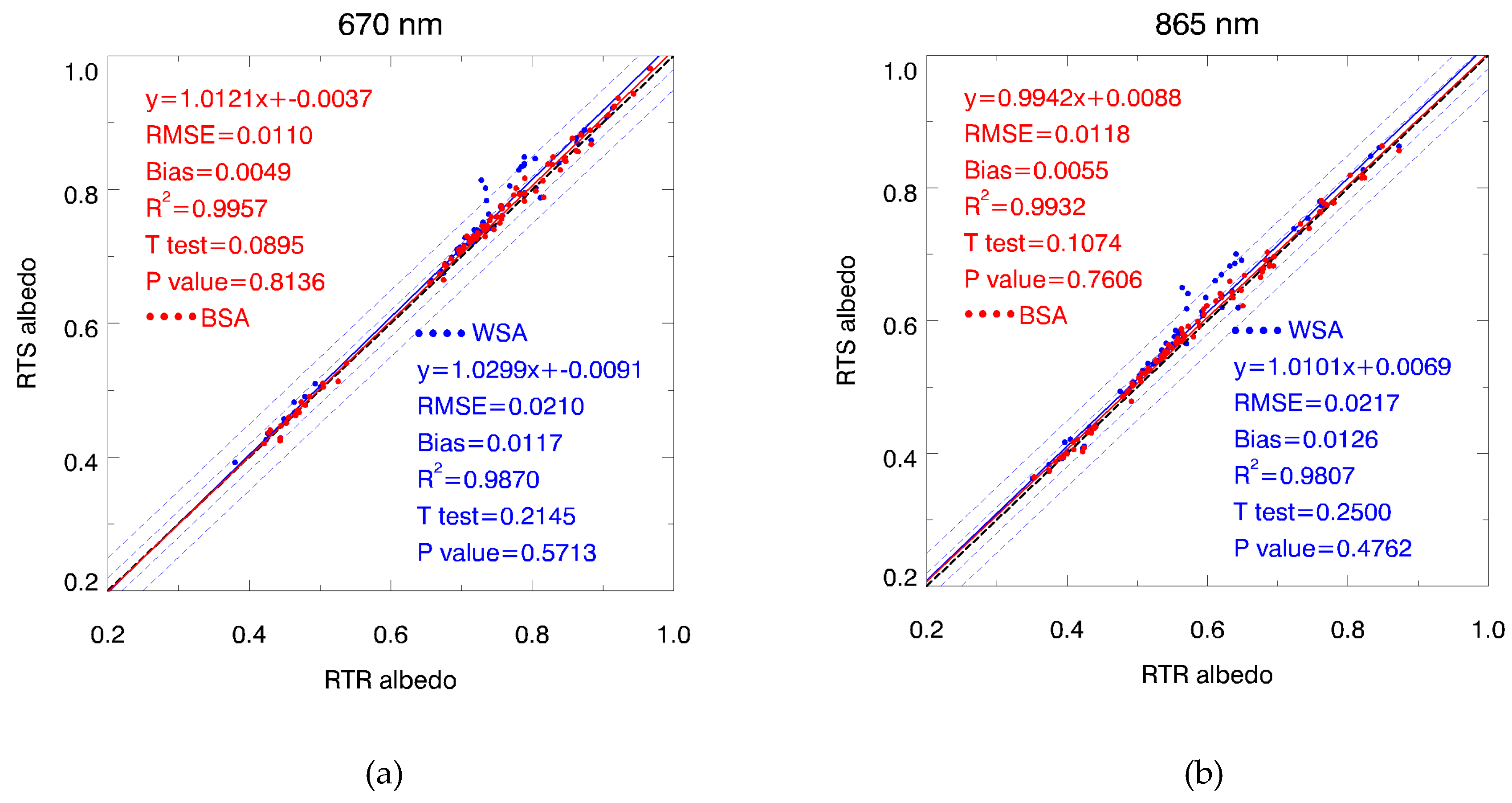
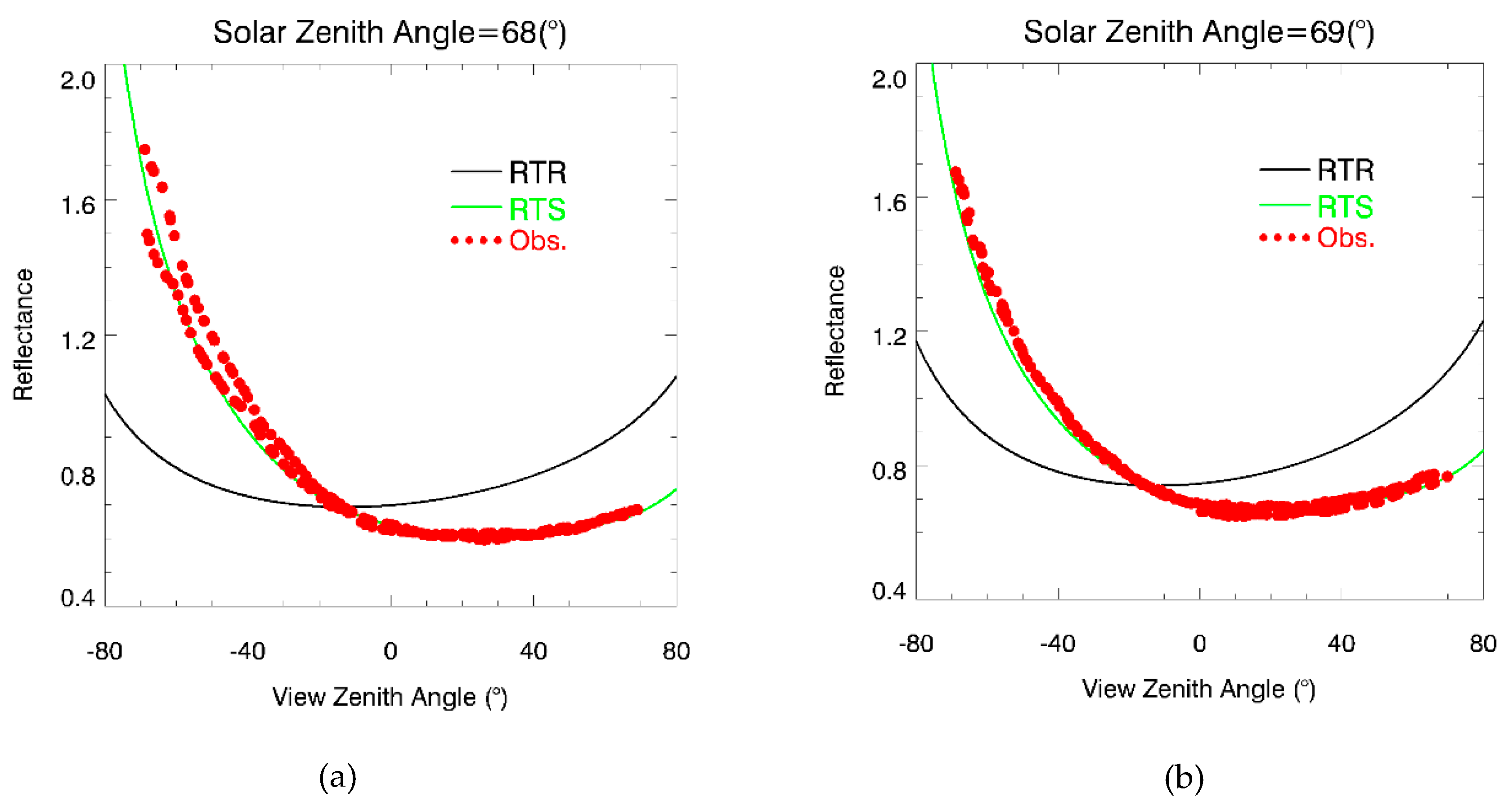
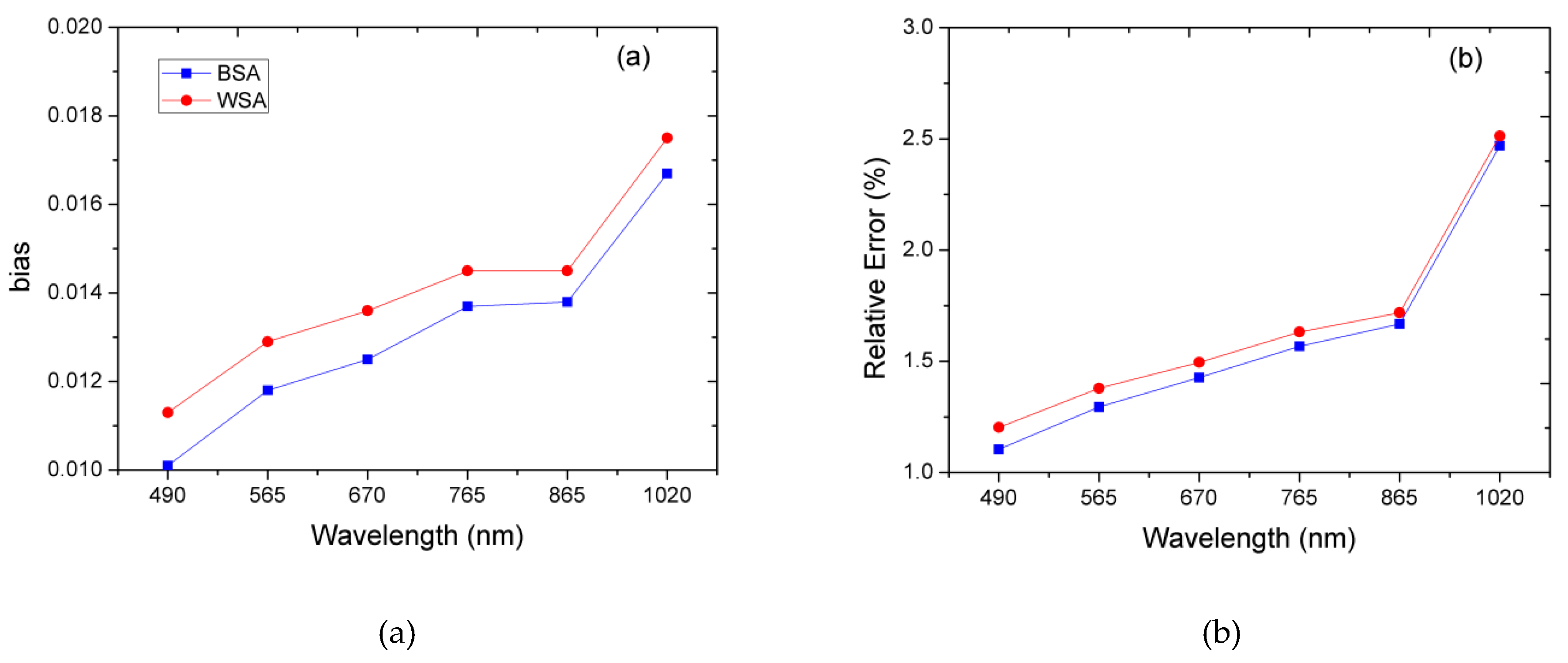
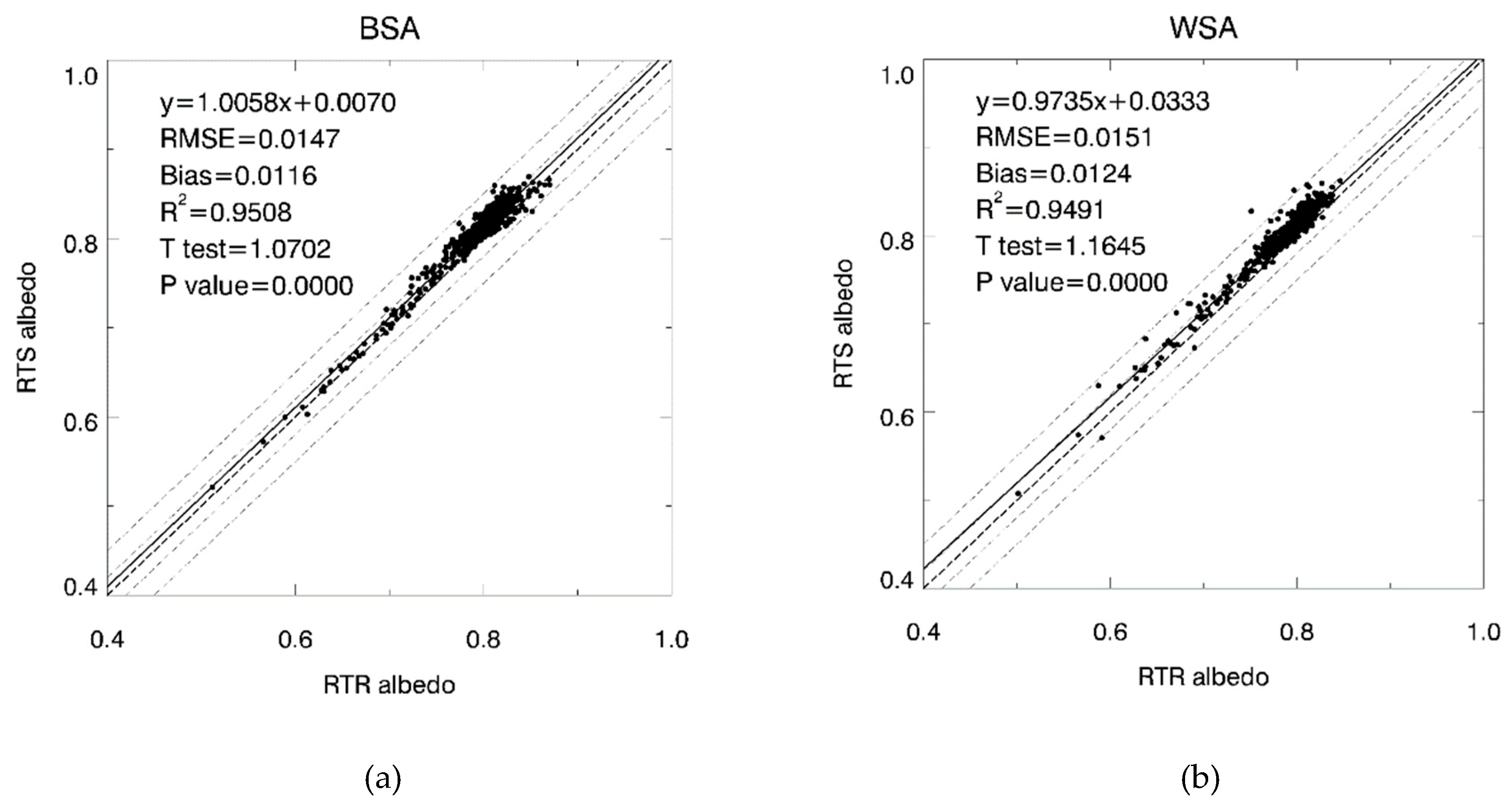
| Parameters | Value | Step | Unit |
|---|---|---|---|
| Monte Carlo superposition (N) | 1000 | - | - |
| photon total | 50,000 | - | - |
| equivalent grain radius | 0.05–0.50 | 0.05 | mm |
| structure parameter (b) | 1–16 | 5 | - |
| snow density | 0.1–0.5 | 0.1 | g/cm3 |
| wavelength number | 2 | - | - |
| wavelength | 0.67–0.865 | 0.195 | μm |
| solar zenith angle | 0–70 | 10 | degrees (°) |
| view zenith angle | 5–70 | 5 | degrees (°) |
| relative azimuth angle | 1–359 | 2 | degrees (°) |
| snow depth | 1.5 | - | m |
| soil reflectance | 0 | - | - |
| streams number | 32 | - | - |
| order number | 4 | - | - |
| Date | Site | Latitude | Longitude | Sample |
|---|---|---|---|---|
| Apr. 2005 | Sodankylä, Etupiha | 67.0021° | 27.2430° | natural snow |
| Apr. 2007 | Tahtela, Sodankylä | 67.3622° | 26.6344° | natural snow |
| Apr. 2008 | Sodankylä | 67.3628° | 26.6355° | new snow; old snow |
| Mar. 2009 | Masala | 60.1719° | 24.5542° | natural snow |
| Apr. 2009 | Kommattivaara, Sodankylä | 67.4211° | 26.7923° | natural snow |
| Jun.–Jul. 2010 | Summit | 72.5961° | -38.4219° | natural snow |
| Mar. 2010 | Sodankylä | 67.3627° | 26.6356° | natural snow |
| Mar. 2013 | Luoman Asema | 60.1721° | 24.5486° | natural snow; snow + dust |
| Apr. 2013 | Sodankylä | 67.3958° | 26.6141° | natural snow; snow + volcanic sand, soot, and silt |
| Model | SZA (°) | fiso | fvol | fgeo | R2 | RMSE | Bias | α |
|---|---|---|---|---|---|---|---|---|
| RTR | 0 | 1.026 | 0.020 | 0.151 | 0.991 | 0.007 | 0.000 | -- |
| 40 | 0.961 | 0.000 | 0.048 | 0.333 | 0.031 | 0.000 | -- | |
| 70 | 0.786 | 0.301 | 0.000 | 0.495 | 0.105 | 0.000 | -- | |
| RTS | 0 | 0.868 | 0.000 | 1.158 | 0.999 | 0.003 | 0.000 | 0.00 |
| 40 | 0.869 | 0.411 | 1.960 | 0.936 | 0.009 | 0.000 | 0.05 | |
| 70 | 0.845 | 0.167 | 0.538 | 0.965 | 0.028 | 0.000 | 0.30 |
| ID | R2 | RMSE | Bias | RE(%) | T-test | P value |
|---|---|---|---|---|---|---|
| 0 | 0.929 | 0.018 | 0.014 | 1.462 | 2.177 | 0.000 |
| 1 | 0.937 | 0.017 | 0.013 | 1.387 | 2.080 | 0.000 |
| 2 | 0.956 | 0.015 | 0.011 | 1.184 | 1.798 | 0.000 |
| 3 | 0.976 | 0.010 | 0.008 | 0.836 | 1.283 | 0.000 |
| 4 | 0.982 | 0.006 | 0.003 | 0.406 | 0.546 | 0.001 |
| 5 | 0.968 | 0.005 | -0.003 | 0.439 | 0.432 | 0.008 |
| 6 | 0.896 | 0.013 | -0.009 | 1.052 | 1.690 | 0.000 |
| 7 | 0.673 | 0.023 | -0.016 | 1.847 | 3.042 | 0.000 |
| 8 | 0.377 | 0.031 | -0.022 | 2.493 | 4.076 | 0.000 |
| 9 | 0.495 | 0.026 | -0.018 | 2.039 | 3.257 | 0.000 |
| ID | R2 | RMSE | Bias | RE(%) | T-test | P value |
|---|---|---|---|---|---|---|
| 0 | 0.877 | 0.008 | 0.003 | 0.602 | 0.493 | 0.001 |
| 1 | 0.894 | 0.008 | 0.003 | 0.551 | 0.495 | 0.001 |
| 2 | 0.925 | 0.007 | 0.003 | 0.451 | 0.507 | 0.001 |
| 3 | 0.952 | 0.005 | 0.003 | 0.364 | 0.478 | 0.001 |
| 4 | 0.976 | 0.004 | 0.002 | 0.293 | 0.337 | 0.021 |
| 5 | 0.991 | 0.002 | 0.000 | 0.175 | 0.005 | 0.971 |
| 6 | 0.952 | 0.007 | -0.003 | 0.410 | 0.576 | 0.000 |
| 7 | 0.838 | 0.015 | -0.008 | 0.972 | 1.397 | 0.000 |
| 8 | 0.633 | 0.025 | -0.016 | 1.904 | 2.824 | 0.000 |
| 9 | 0.599 | 0.030 | -0.020 | 2.391 | 3.429 | 0.000 |
| Model | SZA (°) | fiso | fvol | fgeo | R2 | RMSE | Bias | α |
|---|---|---|---|---|---|---|---|---|
| RTR | 50 | 0.954 | 0.000 | 0.000 | 0.000 | 0.050 | 0.000 | -- |
| 70 | 0.964 | 0.119 | 0.000 | 0.056 | 0.161 | 0.000 | -- | |
| RTS | 50 | 0.973 | 0.000 | 0.838 | 0.950 | 0.011 | 0.000 | 0.19 |
| 70 | 1.006 | 0.000 | 0.721 | 0.961 | 0.033 | 0.000 | 0.30 |
© 2019 by the authors. Licensee MDPI, Basel, Switzerland. This article is an open access article distributed under the terms and conditions of the Creative Commons Attribution (CC BY) license (http://creativecommons.org/licenses/by/4.0/).
Share and Cite
Ding, A.; Jiao, Z.; Dong, Y.; Zhang, X.; Peltoniemi, J.I.; Mei, L.; Guo, J.; Yin, S.; Cui, L.; Chang, Y.; et al. Evaluation of the Snow Albedo Retrieved from the Snow Kernel Improved the Ross-Roujean BRDF Model. Remote Sens. 2019, 11, 1611. https://doi.org/10.3390/rs11131611
Ding A, Jiao Z, Dong Y, Zhang X, Peltoniemi JI, Mei L, Guo J, Yin S, Cui L, Chang Y, et al. Evaluation of the Snow Albedo Retrieved from the Snow Kernel Improved the Ross-Roujean BRDF Model. Remote Sensing. 2019; 11(13):1611. https://doi.org/10.3390/rs11131611
Chicago/Turabian StyleDing, Anxin, Ziti Jiao, Yadong Dong, Xiaoning Zhang, Jouni I. Peltoniemi, Linlu Mei, Jing Guo, Siyang Yin, Lei Cui, Yaxuan Chang, and et al. 2019. "Evaluation of the Snow Albedo Retrieved from the Snow Kernel Improved the Ross-Roujean BRDF Model" Remote Sensing 11, no. 13: 1611. https://doi.org/10.3390/rs11131611
APA StyleDing, A., Jiao, Z., Dong, Y., Zhang, X., Peltoniemi, J. I., Mei, L., Guo, J., Yin, S., Cui, L., Chang, Y., & Xie, R. (2019). Evaluation of the Snow Albedo Retrieved from the Snow Kernel Improved the Ross-Roujean BRDF Model. Remote Sensing, 11(13), 1611. https://doi.org/10.3390/rs11131611









